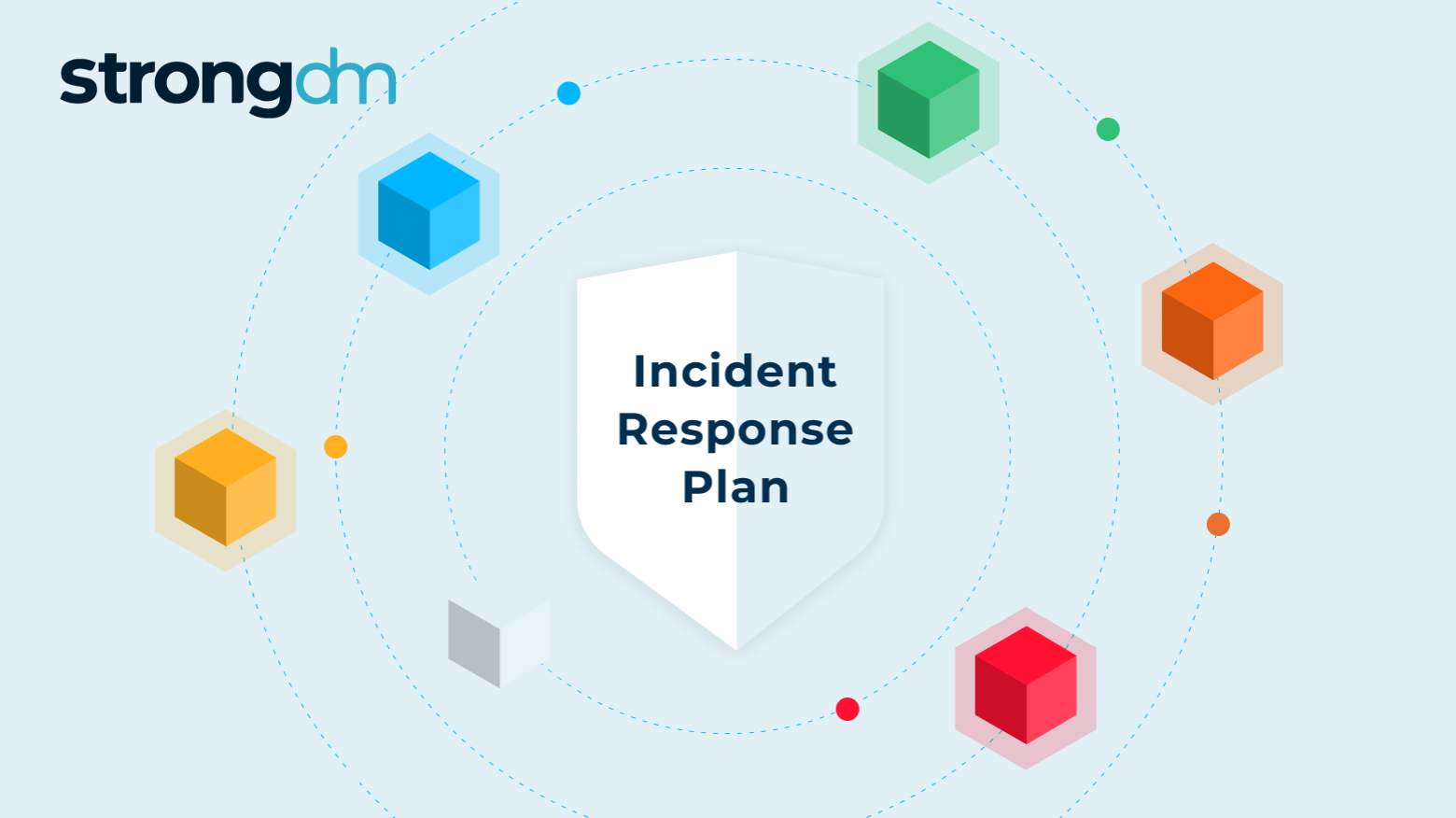
- Role-based, attribute-based, & just-in-time access to infrastructure
- Connect any person or service to any infrastructure, anywhere
- Logging like you've never seen

From phishing campaigns and distributed denial-of-service (DDoS) attacks to ransomware and insider threats, the frequency and severity of cybersecurity incidents are on the rise. The average number of cyber attacks in the first quarter of 2024 rose to 1,308 per organization per week — a 5% increase from Q1 2023 and 28% hike from Q4 2023 — and the average cost of a data breach is up to $4.88 million from $4.45 million last year.
If organizations hope to minimize their exposure to attacks and mitigate any damage done by a threat, they must have a comprehensive incident response plan. An effective plan will detect, contain, and enable rapid recovery from security breaches, preserving your business continuity and operability. We've outlined seven incident response steps for you to follow so you can be prepared for a threat.
Why Have an Incident Response Plan?
A strategic incident response plan should:
- Define all roles within your team
- Specify the duties of each team member
- Triage the urgency of a threat
- Establish protocols for analysis, detection, remediation, recovery, and reporting
- Create a hierarchy for clear communication between team members
If these components aren't clearly defined, team members may fail to respond properly when an incident occurs. The increasingly sophisticated nature of cyber threats makes a rapid, effective response even more urgent, as Information Technology Intelligence Consulting (ITIC) estimates that a single hour of downtime can cost medium or large-sized enterprises over $1 million. Regulations such as NIST 800-61, HIPAA, and the GDPR require that organizations have an incident response plan in place for many data protection policies, meaning that failure to do so could result in a costly compliance violation.
Step 1: Preparation
The first step in building a strong incident response plan is to inventory your people, tools, and processes. This involves designating team members, identifying key assets, and ensuring proficiency with the tools needed for defense. The preparation phase includes:
- Incident Response Team (IRT): Form a Computer Security Incident Response Team (CSIRT), assign roles (incident commander, IT/security leads, legal advisors, etc.), and create a crisis communication plan for internal and external coordination.
- Risk Assessments & Incident Classification: Identify critical assets and their vulnerabilities, then classify potential incidents by severity.
- Implement Detection and Monitoring Tools: Use SIEM, endpoint detection, access controls, and IAM tools to detect threats, conduct forensics, and streamline communication.
- Cybersecurity Awareness Training: Train employees on phishing, malware detection, and reporting protocols to minimize human error.
💡Make it easy: StrongDM helps you prepare your incident response plan by providing secure, real-time access management to critical systems without compromising security. Our centralized hub possesses all the tools needed to implement a Zero Trust Architecture (ZTA), minimizing your attack surface and strengthening your incident response.
Step 2: Identification
After you've taken a high-level overview of your team, assets, and environment, the next phase is to identify incoming threats. Steps in this phase include:
- Monitor Precursors and Indicators. Precursors indicate that an attack may occur in the future and are useful for revealing potential vulnerabilities, while indicators act as alerts by providing concrete evidence that an incident has already occurred or is underway. Use both to assess your vulnerability status.
- Triage Your Response. You created an incident classification framework in Phase 1, so prioritize your incident response based on the damage you found that each incident could do. Such triaging is the most important component of the identification phase according to NIST, so score the urgency of each incident based on its impact on business continuity, the confidentiality of affected information, and the recoverability of the breach.
- Document the Incident. Incident documentation can help you reduce the number of false positives, adhere to compliance requirements, and enhance your threat intelligence. Implement thorough documentation tools so that no detail gets overlooked.
💡Make it easy: StrongDM provides real-time visibility across your environment so that you can detect and respond to threats with greater efficiency. Our platform consolidates your detection and analysis tools into a single interface, streamlining your threat identification protocols.
Step 3: Containment
Once you identify the threat, begin taking steps to mitigate the damage that's already been done. Phase 3 of your Security Incident Response Policy (SIRP) consists of reducing the "blast radius," or the impact of a security breach. This can be done by:
- Short-Term Containment. This phase consists of immediate actions, such as isolating systems, disabling compromised accounts, and restricting access to prevent any further spread of the damage.
- Long-Term Containment. In this phase, teams implement more sustainable containment measures to prevent future attacks. Examples include segmentation of networks and applying updates and patches.
- Forensic Preservation. As you contain the breach, it's essential to preserve any evidence you find. This will allow you to analyze the incident later and identify opportunities for a better response and can be useful for litigation, allowing you to recover some of your losses.
💡Make it easy: StrongDM's logging capabilities disable accounts and isolate systems to contain any damage done in the short term, and its reporting features are useful for preserving important evidence for forensic investigation.
Step 4: Eradication
It's not enough to simply contain the damage done by a breach — eventually, you must root it out. The NIST framework combines the eradication phase with containment, but there are several distinct components within each. The eradication phase consists of:
- Investigate the Root Cause. Some cyber attacks may appear to take one form at first but have their roots in another. For example, a ransomware attack could be the result of an insider threat, so conduct a root cause analysis to ensure that the full extent of the threat is discovered.
- Threat Removal. Content threat removal (CTR) removes malware from incoming data sources, and content disarm and reconstruction (CDR) eliminates all executable files that aren't allowed by your network. Deleting unauthorized accounts also removes threats from your environment.
- System Hardening. Once the threat is eradicated, harden your defenses so your system will be less prone to an attack in the future. Apply patches and updates, close vulnerabilities, employ encryption for data at rest and in transit, and strengthen your security policies.
💡Make it easy: StrongDM is an essential tool for investigating and eradicating threats. Our platform lets you trace access activity to discover the origin of the threat, and our hardening functionalities let you bolster your system vulnerabilities.
Step 5: Recovery
Once you've ejected the threat from your system, it's time to restore your environment and the list of your operations. Steps in the recovery phase include:
- System Restoration: Create a three-tiered environment for your recovery process: "Green light" for fully restored systems, "Red light" for compromised systems, and "Yellow light" for those potentially affected by nearby issues. Ensure you communicate the status of systems to users, partners, and stakeholders, and prioritize restoring the most critical systems first.
- Data Recovery: Implement backup protocols to restore systems to their last known healthy state, using the most recent backup point before the attack. Perform data integrity checks to confirm all data is intact and accurate.
- Continuous Monitoring: Even after restoration, some threats may persist. Maintain continuous monitoring during and after recovery to detect any remaining threats and ensure the system remains secure.
💡Make it easy: StrongDM helps maintain strict access control during the recovery process, ensuring only authorized personnel can access sensitive systems.
Step 6: Post-Incident Review & Lessons Learned
Cyber attacks are damaging, but they provide excellent opportunities to review your IT environment and policies and learn where you can grow. Organizations that don't prioritize post-incident review are likely to leave themselves vulnerable to the same attacks in the future and could miss out on chances to improve their broader security posture.
Steps in the review phase are:
- Conduct a Post-Mortem Analysis. Analyze where your incident response procedure succeeded as well as any areas for growth. Then, conduct lessons-learned meetings with stakeholders across the organization and educate employees on any policies that may have been overlooked.
- Update the Incident Response Plan. Use your findings in the lessons-learned meeting to refine your incident response processes, and implement additional strategies to improve your resilience.
- Enhance Threat Intelligence. Your breach may have come from a classic phishing attempt, or it may have been the byproduct of a novel system using AI. Add the report on your breach to your threat intelligence system so you can stay current on emerging tactics and threats.
💡Make it easy: StrongDM’s detailed logs provide insights into access-related incidents. This gives you clear answers on what went right and wrong in the incident response process, letting you better prepare for the future.
Step 7: Continuous Improvement & Testing
The incident response process is iterative. Cyber threats are constantly becoming more complex, with new attack vectors emerging every day. If organizations hope to keep up, they must continually test their incident response procedures and refine them to maintain their security posture.
To do this, teams should test their incident response capabilities by using simulations, tabletop exercises, and penetration tests. They should also implement Security Orchestration, Automation, and Response (SOAR) platforms to lighten the workload for security teams by leveraging automation so that they can focus on higher-level security efforts. Through these measures, teams can improve their incident response processes and streamline their workflows for the future.
💡Make it easy: StrongDM integrates seamlessly with your existing tools to automate secure access, provisioning, and monitoring. This reduces your incident response time, making you more efficient the next time an incident occurs.
Develop a Robust Incident Response Plan With StrongDM
The threat landscape is evolving at breakneck speed — especially with the rise of artificial intelligence (AI). Implementing a strong incident response plan is, therefore, a must for organizations seeking to maintain their cybersecurity posture, but a single draft will rarely suffice. As new threats emerge, your incident response plan will need to be resolved and tested to make sure that all bases are covered. Otherwise, new gaps could pop up.
StrongDM's Zero Trust Privileged Access Management platform helps you strengthen your access control protocols and bolster your incident readiness. Our solution combines authentication, authorization, and auditing workflows into a single centralized hub, enabling seamless and secure access management for every member of your team.
The result of our robust access controls and real-time monitoring is more granular control and full visibility over user activity, leading to greater productivity, less overhead, better compliance, and a stronger security posture. These advantages help your team prepare for and respond to a threat with greater efficiency than legacy systems, so book a demo today to see what we can do.
About the Author
John Martinez, Technical Evangelist, has had a long 30+ year career in systems engineering and architecture, but has spent the last 13+ years working on the Cloud, and specifically, Cloud Security. He's currently the Technical Evangelist at StrongDM, taking the message of Zero Trust Privileged Access Management (PAM) to the world. As a practitioner, he architected and created cloud automation, DevOps, and security and compliance solutions at Netflix and Adobe. He worked closely with customers at Evident.io, where he was telling the world about how cloud security should be done at conferences, meetups and customer sessions. Before coming to StrongDM, he lead an innovations and solutions team at Palo Alto Networks, working across many of the company's security products.

You May Also Like




